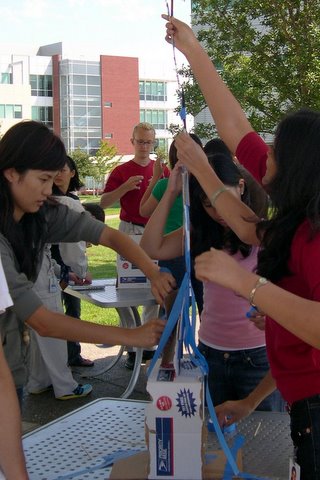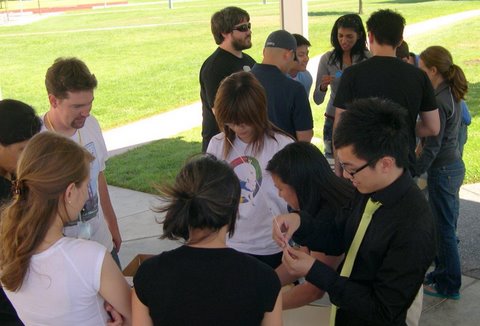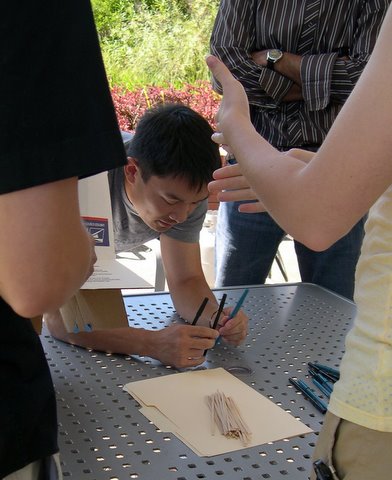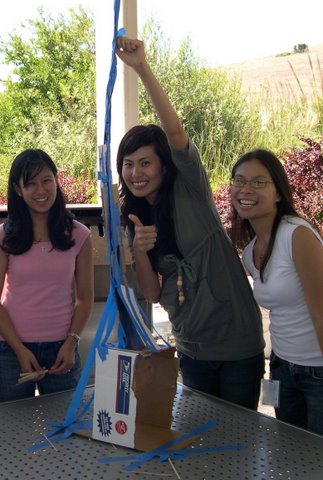Difference between revisions of "The Tallest Tower"
m |
|||
| Line 56: | Line 56: | ||
You should then introduce the representatives to the activity by simply saying "This is an activity to work on communication and collaboration, and the goal is to build the tallest free standing tower you can with the supplies in the bags. There will be prizes (or bragging rights) for the winners." | You should then introduce the representatives to the activity by simply saying "This is an activity to work on communication and collaboration, and the goal is to build the tallest free standing tower you can with the supplies in the bags. There will be prizes (or bragging rights) for the winners." | ||
| + | Some have added the "option" to destroy a tower in their materials. One group may receive the ability to destroy a tower, while another groups receives the ability to protect their tower. The group may or may not announce that they have received such privilege, but it's up to their discretion if they want to use this or not. | ||
You should be careful to introduce the activity without giving too much context or answering too many questions. Again the key here is that each group will have a different set of supplies but the facilitators should make sure this is not immediately obvious. Once it becomes more obvious, the facilitators should neither discourage or encourage collaboration and sharing. The vast majority of participants when divided into groups, will assume they they should be competing against the other groups but you should not specifically say it is a competition. You will address this in the debrief questions based on the groups' choice to collaborate or compete. | You should be careful to introduce the activity without giving too much context or answering too many questions. Again the key here is that each group will have a different set of supplies but the facilitators should make sure this is not immediately obvious. Once it becomes more obvious, the facilitators should neither discourage or encourage collaboration and sharing. The vast majority of participants when divided into groups, will assume they they should be competing against the other groups but you should not specifically say it is a competition. You will address this in the debrief questions based on the groups' choice to collaborate or compete. | ||
Latest revision as of 06:31, 26 November 2013
Objectives
Communication | Collaboration | Team Strategy
- Illustrate the importance of collaboration and communication.
Group Size
Materials
For this activity you need some building supplies such as:
- Paper Cups, plates, bowls
- Popsicle Sticks or coffee stirrers
- Cheap pens or pencils
- Construction Paper or cardboard
- and you must have some tape (masking tape works best)
- a bag of candy or another similar prize with enough for everyone (alternatively you can just use "bragging rights" as the prize)
Set Up
Before the activity, you need to make a packet of supplies for each group. Divide your class into groups of 4-5. If you have less than 12 people, this is probably not the right activity for you. The key here is to divide the supplies unevenly, but put them in a closed bag or box, so that participants can't see that each group is getting a different set of supplies. Each group should have a lot of one supply, and only some of the other supplies.
For example:
Packet #1 -
- 1 roll of Masking Tape
- 10 Paper Cups
- 5 Popsicle Sticks
- 4 sheets of construction paper
Packet #2
- a 12” strip of Masking Tape (wound around a pen)
- 25 Paper Cups
- 5 Popsicle Sticks
- 8 sheets of construction paper
Packet #3
- a really small piece of Masking Tape
- 10 Paper Cups
- 35 Popsicle Sticks
- 1 sheets of construction paper
Directions
Big picture: The participants work to build the tallest free-standing tower they can with the supplies given.
Begin by randomly dividing participants into small groups and organizing the groups in different areas of the room. Ask for a representative from each group to come to a separate space (center of the room or a separate room) to receive instructions and materials. Pass out one bag of supplies to each group representative.
You should then introduce the representatives to the activity by simply saying "This is an activity to work on communication and collaboration, and the goal is to build the tallest free standing tower you can with the supplies in the bags. There will be prizes (or bragging rights) for the winners."
Some have added the "option" to destroy a tower in their materials. One group may receive the ability to destroy a tower, while another groups receives the ability to protect their tower. The group may or may not announce that they have received such privilege, but it's up to their discretion if they want to use this or not.
You should be careful to introduce the activity without giving too much context or answering too many questions. Again the key here is that each group will have a different set of supplies but the facilitators should make sure this is not immediately obvious. Once it becomes more obvious, the facilitators should neither discourage or encourage collaboration and sharing. The vast majority of participants when divided into groups, will assume they they should be competing against the other groups but you should not specifically say it is a competition. You will address this in the debrief questions based on the groups' choice to collaborate or compete.
Answer questions at this point. Try to be very general in answering questions from the representatives. If they have specific process questions, it may be helpful to say something like, "you have received all the instructions I can give you. You and your group will have to figure out the rest".
Then announce that the representatives will return to the groups, and once they return, the facilitators will not answer any more questions. The facilitators should not answer any questions so that the groups are forced to figure out how they want to build on their own. If the groups decide they want to collaborate, the facilitators should neither encourage or discourage them (this will come up in the debrief).
Announce that they have ~20 min to build, and let the building begin.
Some groups will spend time coming up with a detailed strategy, others will just dive right in. Some may start to notice that they don't have much tape, or that the other groups have more popsicle sticks.
After a few minutes of building you have a few choices.
- You can ask for representatives to come to the center of the room and report to the other reps one thing they are doing well and one challenge they are having.
- You can have everyone stop building for a moment and walk around and see other teams' progress so far
Again, the facilitators should not answer any questions, and should not encourage or discourage collaboration!
It is important to try to deflect... so if they ask, "How come they have so much more tape?" you might say "Sorry, I can't really answer any questions at this point, but it looks like you are making good progress."
As they start to see that other groups have different supplies, some will respond by questioning, some will try to beg, barter, or steal supplies, and some will just resign themselves to the fact that it's not fair and will continue to focus on working with what they have.
Make notes of it all, and save it for the debrief.
Debrief
Because of the unequal distribution of supplies, in order to build the tallest tower possible, the groups really have to all merge and share supplies. But because you divided them into groups, and that implies competition to most people, very few participants will try to suggest that the groups collaborate or share supplies. Even if someone in the group suggests it, it is not likely that everyone will agree to it.
The facilitators should ask the following questions of the entire group.
- Raise your hand if you helped build a tower!
- What worked well?
- What challenges did you encounter and how did you overcome them?
- Did you build the tallest tower you could? Why or why not?
Add the following questions if the groups did not collaborate or share supplies:
- Did you assume that you were only supposed to collaborate with those in your small group?
- What would have been possible if you had decided to share resources with the whole group?
- Would you have had a taller tower?
- Why didn't you?
Add the following questions if the groups collaborate:
- How did you come to the decision to collaborate?
- What became possible once you made the decision to share resources?
- What was challenging?
And then to make the issues really hit home, you need to tie it back to collaboration and communication on your specific team or group:
- How does building the tower in this activity compare to your daily work? or the way our group is organized?
- How does this activity relate to being part of the larger company, organization, or group?
- How can we encourage collaboration, communication, and sharing among the whole group?



